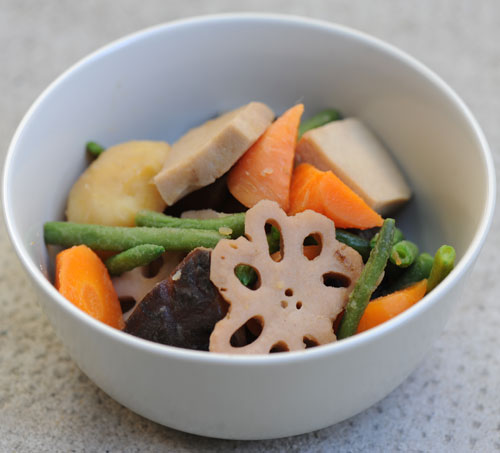Stewed winter vegetables with kouya dofu (freeze dried tofu)

Salads and such are fine in the warm months, but now that it's cold outside here in the northern hemisphere, I tend to prefer cooked vegetables. This homey stewed vegetable dish is rather typical of Japanese 'mom's cooking' - seasonal vegetables all cooked together in a dashi based broth. (I know that green beans are not exactly seasonal, but they are added just for the color; use any green vegetable instead.) It does take a while to assemble and cook, but once you have a big potful it lasts for a few days, so it's a great refrigerator stock dish.
I've tried to use 'ordinary', non-exotic vegetables as much as possible, but I did add a little lotus root since it adds visual flair as well as a nice crunchy texture. This is a one-pot meal due to the addition of potatoes for carbs, and meaty-textured kouya dofu or freeze dried tofu (for which you can substitute extra-firm tofu or even chicken pieces) for protein. You can just pack this into a bento box on its own, or accompany it with rice and pickles.
Recipe: Stewed winter vegetables with kouya dofu
Makes a big potful.
The cooking broth:
- 6 cups dashi stock - traditional bonito/konbu base or vegan konbu/shiitake base - or use water with dashi granules
- 3 tbs. mirin
- 2 tbs. sake
- 1 tbs. sugar
- 4 tbs. soy sauce
- 1/2 tsp. sea salt
The vegetables etc:
- 4 inch / 10cm length of the white part of a leek
- 1 inch / 2 cm piece of fresh ginger
- 1 tsp. sesame oil
- 1 small (7 inch / 20cm long) section of fresh lotus root, or 8-10 slices of precooked, vacuum packed lotus root
- 4 medium boiling potatoes
- 3 large or 4 medium carrots
- 6 large or 8 medium fresh shiitake mushrooms
- 3 pieces of kouya dofu (freeze-dried tofu), or 1 large block (1lb/450g, or 2 medium blocks) of extra firm tofu, or 8 oz. skinless boneless chicken thigh meat
- 1 cup frozen precut green beans, or snow peas (for color)
If you are using fresh lotus root, optionally cut it into a decorative flower shape as shown in the photo by slicing the root into thick slices, then cutting in between the holes on the outer layer. Peel off the skin. Put the slices into water with a little vinegar added and set aside.
Soak the kouya dofu in plenty of water, until they have swollen up and softened - see the kouya dofu in-depth page. Once they are reconstituted, take out and gently squeeze out excess water. Cut into quarters. If you are using extra-firm tofu, drain and cut into large chunks. If using chicken, cut into bite size pieces.
Slice the leek thinly. Peel and slice the ginger. Peel and cut the potatoes and carrots into chunks. Note: The usual way to cut up carrot, potato and other chunky vegetables for stewing is called rangiri, or random cut. For a carrot you cut it along the cutting lines in this diagram, turning your knife one way then another (it's way more complicated to describe than to do!):

Cut the stems off the shiitake mushrooms, and slice the caps into halves or quarters, depending on how big they are.
In a large, heavy-bottomed pot, sauté the leeks and ginger until the oil is fragrant. Add the cooking broth ingredients and the carrots, drained lotus root, shiitake and kouya dofu. (If you are using extra-firm tofu or chicken instead, add these when you add the potatoes.) Bring up to a boil, then lower the heat to a simmer. After about 15 minutes add the potatoes. Simmer gently until the vegetables are tender, an additional 15-20 minutes. Add the green beans or snowpeas in the last 5 minutes.
This tastes better the day after they are made, as it absorbs more flavor from the cooking broth. Store in the refrigerator, liquid and all. Drain off the liquid before packing into a bento box. After a couple of days you will want to heat it through and re-cool before packing.
You can chop up the vegetables to add to fried rice, miso soup, and so on too.
Vegetable variations
Try using taro root or satoimo instead of the potatoes. Sweet potato can be used too, but it tends to disintegrate, so you may want to add it later on in the cooking process.
Try turnips, kohlrabi or rutabaga, as well as daikon radish, in addition to or instead of the lotus root.
If you enjoyed this article, please consider supporting this site by becoming my patron via Patreon.
